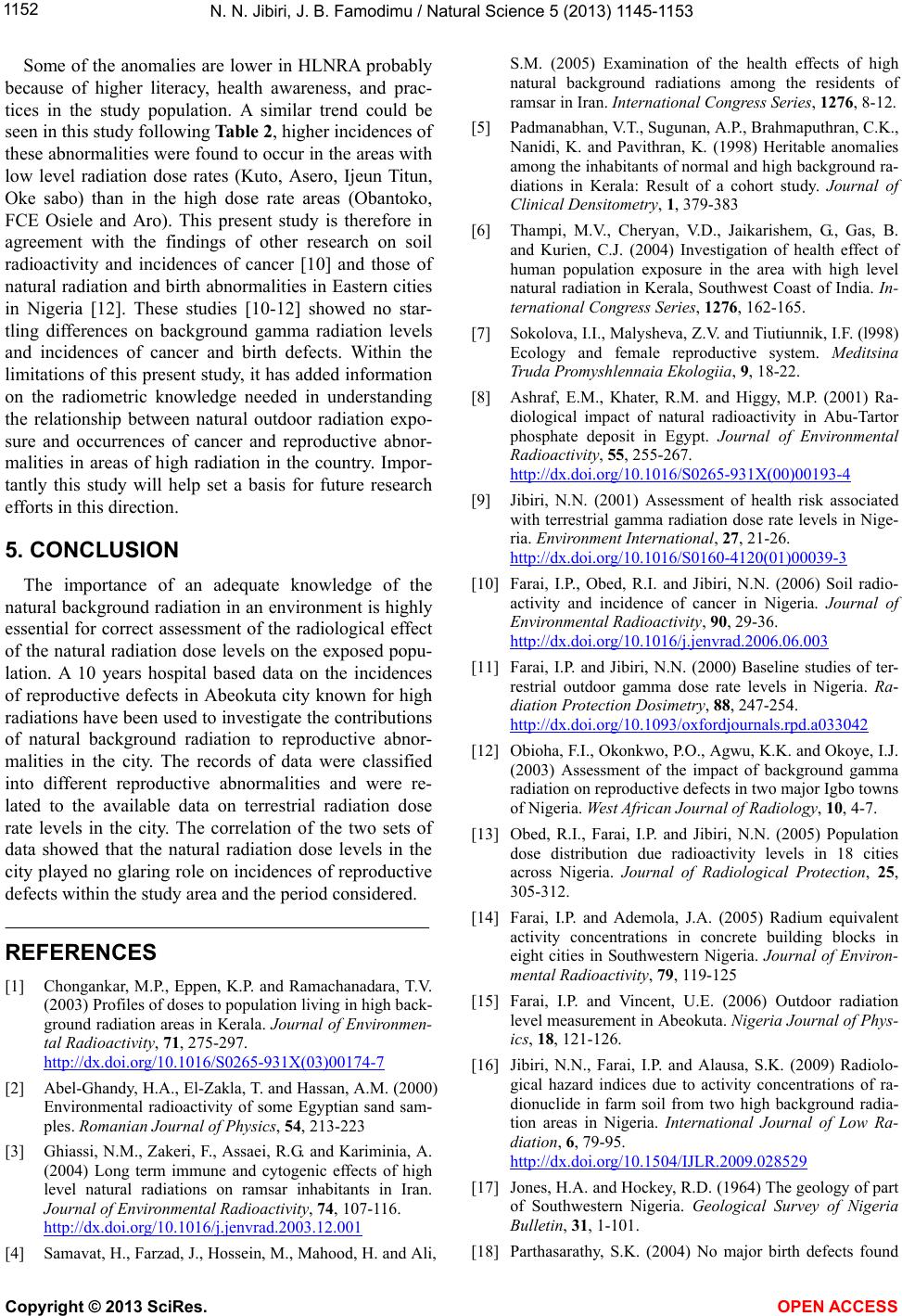
N. N. Jibiri, J. B. Famodimu / Natural Science 5 (2013) 1145-1153
1152
Some of the anomalies are lower in HLNRA probably
because of higher literacy, health awareness, and prac-
tices in the study population. A similar trend could be
seen in this study following Table 2, higher incidences of
these abnormalities were found to occur in the areas with
low level radiation dose rates (Kuto, Asero, Ijeun Titun,
Oke sabo) than in the high dose rate areas (Obantoko,
FCE Osiele and Aro). This present study is therefore in
agreement with the findings of other research on soil
radioactivity and incidences of cancer [10] and those of
natural radiation and birth abnormalities in Eastern cities
in Nigeria [12]. These studies [10-12] showed no star-
tling differences on background gamma radiation levels
and incidences of cancer and birth defects. Within the
limitations of this present study, it has added information
on the radiometric knowledge needed in understanding
the relationship between natural outdoor radiation expo-
sure and occurrences of cancer and reproductive abnor-
malities in areas of high radiation in the country. Impor-
tantly this study will help set a basis for future research
efforts in this direction.
5. CONCLUSION
The importance of an adequate knowledge of the
natural background radiation in an environment is highly
essential for correct assessment of the radiological effect
of the natural radiation dose levels on the exposed popu-
lation. A 10 years hospital based data on the incidences
of reproductive defects in Abeokuta city known for high
radiations have been used to investigate the contributions
of natural background radiation to reproductive abnor-
malities in the city. The records of data were classified
into different reproductive abnormalities and were re-
lated to the available data on terrestrial radiation dose
rate levels in the city. The correlation of the two sets of
data showed that the natural radiation dose levels in the
city played no glaring role on incidences of reproductive
defects within the study area and the period considered.
REFERENCES
[1] Chongankar, M.P., Eppen, K.P. and Ramachanadara, T.V.
(2003) Profiles of doses to population living in high back-
ground radiation areas in Kerala. Journal of Environmen-
tal Radioacti vity, 71, 275-297.
http://dx.doi.org/10.1016/S0265-931X(03)00174-7
[2] Abel-Ghandy, H.A., El-Zakla, T. and Hassan, A.M. (2000)
Environmental radioactivity of some Egyptian sand sam-
ples. Romanian Journal of Physics, 54, 213-223
[3] Ghiassi, N.M., Zakeri, F., Assaei, R.G. and Kariminia, A.
(2004) Long term immune and cytogenic effects of high
level natural radiations on ramsar inhabitants in Iran.
Journal of Environmental Radioactivity, 74, 107-116.
http://dx.doi.org/10.1016/j.jenvrad.2003.12.001
[4] Samavat, H., Farzad, J., Hossein, M., Mahood, H. and Ali,
S.M. (2005) Examination of the health effects of high
natural background radiations among the residents of
ramsar in Iran. International Congress Series, 1276, 8-12.
[5] Padmanabhan, V.T., Sugunan, A.P., Brahmaputhran, C.K.,
Nanidi, K. and Pavithran, K. (1998) Heritable anomalies
among the inhabitants of normal and high background ra-
diations in Kerala: Result of a cohort study. Journal of
Clinical Densitometry, 1, 379-383
[6] Thampi, M.V., Cheryan, V.D., Jaikarishem, G., Gas, B.
and Kurien, C.J. (2004) Investigation of health effect of
human population exposure in the area with high level
natural radiation in Kerala, Southwest Coast of India. In-
ternational Congress Series, 1276, 162-165.
[7] Sokolova, I.I., Malysheva, Z.V. and Tiutiunnik, I.F. (l998)
Ecology and female reproductive system. Meditsina
Truda Promyshlennaia Ekologiia, 9, 18-22.
[8] Ashraf, E.M., Khater, R.M. and Higgy, M.P. (2001) Ra-
diological impact of natural radioactivity in Abu-Tartor
phosphate deposit in Egypt. Journal of Environmental
Radioactivity, 55, 255-267.
http://dx.doi.org/10.1016/S0265-931X(00)00193-4
[9] Jibiri, N.N. (2001) Assessment of health risk associated
with terrestrial gamma radiation dose rate levels in Nige-
ria. Environment International, 27, 21-26.
http://dx.doi.org/10.1016/S0160-4120(01)00039-3
[10] Farai, I.P., Obed, R.I. and Jibiri, N.N. (2006) Soil radio-
activity and incidence of cancer in Nigeria. Journal of
Environmental Radioactivity, 90, 29-36.
http://dx.doi.org/10.1016/j.jenvrad.2006.06.003
[11] Farai, I.P. and Jibiri, N.N. (2000) Baseline studies of ter-
restrial outdoor gamma dose rate levels in Nigeria. Ra-
diation Protection Dos imetry, 88, 247-254.
http://dx.doi.org/10.1093/oxfordjournals.rpd.a033042
[12] Obioha, F.I., Okonkwo, P.O., Agwu, K.K. and Okoye, I.J.
(2003) Assessment of the impact of background gamma
radiation on reproductive defects in two major Igbo towns
of Nigeria. West African Journal of Radiology, 10, 4-7.
[13] Obed, R.I., Farai, I.P. and Jibiri, N.N. (2005) Population
dose distribution due radioactivity levels in 18 cities
across Nigeria. Journal of Radiological Protection, 25,
305-312.
[14] Farai, I.P. and Ademola, J.A. (2005) Radium equivalent
activity concentrations in concrete building blocks in
eight cities in Southwestern Nigeria. Journal of Environ-
mental Radioactivity, 79, 119-125
[15] Farai, I.P. and Vincent, U.E. (2006) Outdoor radiation
level measurement in Abeokuta. Nigeria Journal of Phys-
ics, 18, 121-126.
[16] Jibiri, N.N., Farai, I.P. and Alausa, S.K. (2009) Radiolo-
gical hazard indices due to activity concentrations of ra-
dionuclide in farm soil from two high background radia-
tion areas in Nigeria. International Journal of Low Ra-
diation, 6, 79-95.
http://dx.doi.org/10.1504/IJLR.2009.028529
[17] Jones, H.A. and Hockey, R.D. (1964) The geology of part
of Southwestern Nigeria. Geological Survey of Nigeria
Bulletin, 31, 1-101.
[18] Parthasarathy, S.K. (2004) No major birth defects found
Copyright © 2013 SciRes. OPEN A CCESS